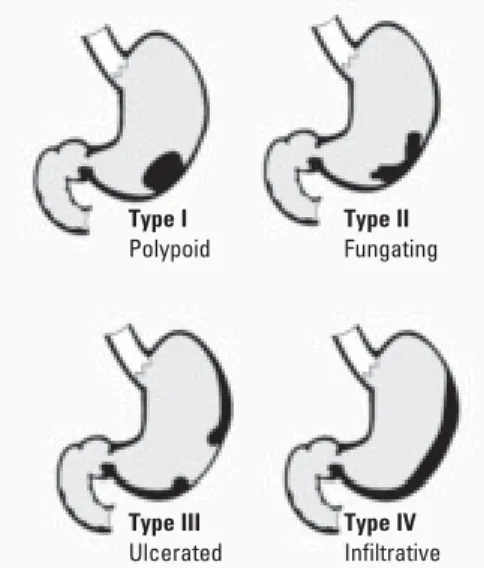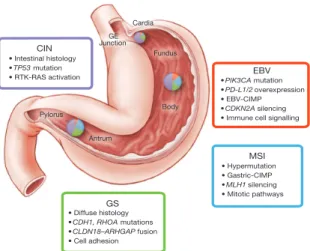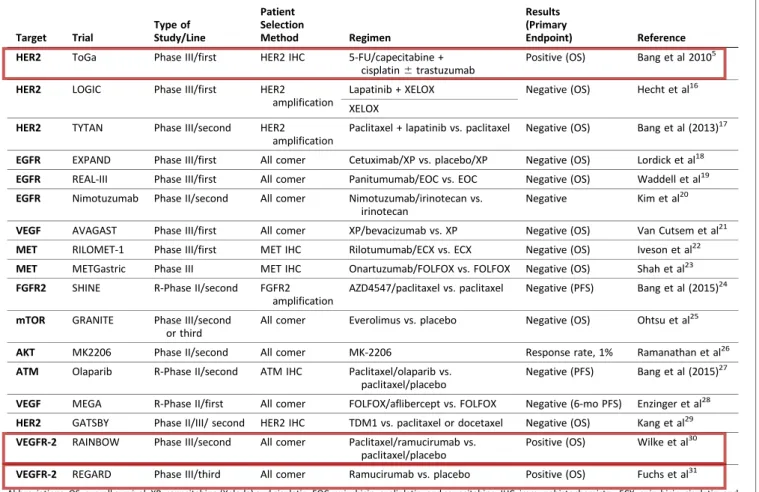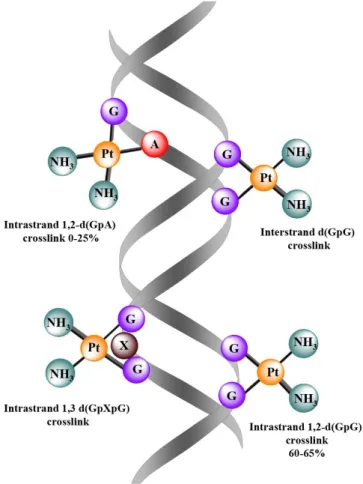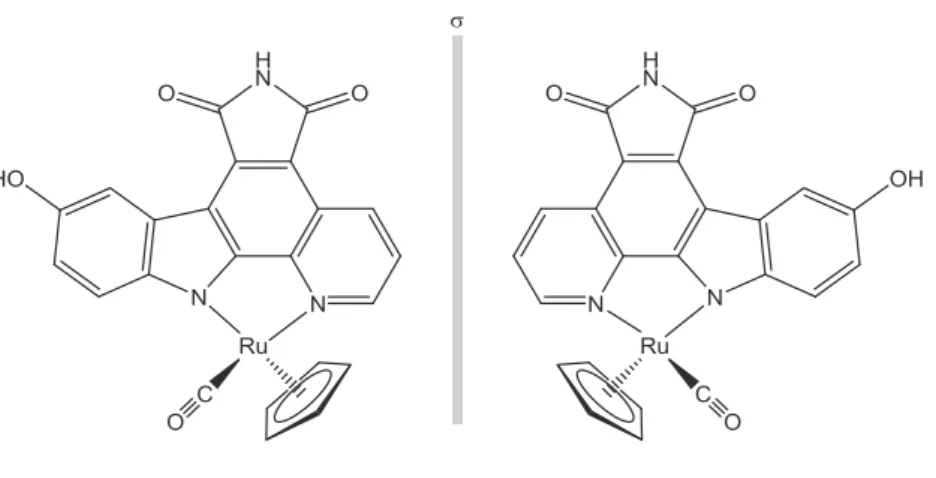HAL Id: tel-01561028
https://tel.archives-ouvertes.fr/tel-01561028
Submitted on 12 Jul 2017
HAL is a multi-disciplinary open access
archive for the deposit and dissemination of sci-entific research documents, whether they are pub-lished or not. The documents may come from teaching and research institutions in France or abroad, or from public or private research centers.
L’archive ouverte pluridisciplinaire HAL, est destinée au dépôt et à la diffusion de documents scientifiques de niveau recherche, publiés ou non, émanant des établissements d’enseignement et de recherche français ou étrangers, des laboratoires publics ou privés.
Implication of epigenetic modifications in response to
chemotherapies in gastric cancer : therapeutic
perspectives
Marie-Elodie Spaety
To cite this version:
Marie-Elodie Spaety. Implication of epigenetic modifications in response to chemotherapies in gas-tric cancer : therapeutic perspectives. Cancer. Université de Strasbourg, 2016. English. �NNT : 2016STRAJ043�. �tel-01561028�
UNIVERSITÉ DE STRASBOURG
ÉCOLE DOCTORALE DES SCIENCES DE LA VIE ET DE LA SANTE (ED 414)
Inserm U1113 - Voies de signalisation du développement et du stress cellulaire
dans les cancers digestifs et urologiques
THÈSE
présentée par :Marie-Elodie SPAETY
soutenue le : 14 septembre 2016
pour obtenir le grade de :
Docteur de l’université de Strasbourg
Discipline/ Spécialité
: Aspects Moléculaires et Cellulaires de la Biologie
Implication des régulations épigénétiques dans
la réponse aux chimiothérapies dans les cancers
gastriques – Perspectives thérapeutiques
THÈSE dirigée par :
Mr GAIDDON Christian Directeur de Recherche, Université de Strasbourg
Mr PFEFFER Sébastien Directeur de Recherche, Université de Strasbourg RAPPORTEURS :
Mr SAVA Gianni PR PUPH, Université de Trieste
Mr JUNG Manfred PR PUPH, Université de Freiburg
AUTRES MEMBRES DU JURY :
Mme MASSON Murielle Chargé de recherche, Université de Strasbourg
I. GASTRIC)CANCER)
...
12)
1.Epidemiology)...12) 2.Classifica;ons)of)gastric)carcinoma)...14) 2.1. Clinical*classifica-ons*...14* 2.1.1. Cancers+at+gastric+cardia+region+and+gastroesophageal+junc6on+...14+ 2.1.2. Early+and+advanced+gastric+carcinoma+...15+ 2.2. Histological*classifica-ons*...16* 2.2.1. Lauren+classifica6on+...16+ 2.2.2. WHO+classifica6on+...17+ 3.Pathogenesis)...18) 3.1. Precancerous*cascade*...18* 3.2. Risk*factors*...19* 3.2.1. Helicobacter+pylori+infec6on+...19+ 3.2.2. Others+risk+factors+...21+ 3.3. Hereditary*syndromes*...23* 4.Molecular)characteriza;ons)of)GC)...24) 4.1. The*Cancer*Genome*Atlas*(TCGA)*molecular*classifica-on*...24* 4.2. Asian*Cancer*Research*Group*(ACRG)*molecular*classifica-on*...26* 5.Treatment)...28) 5.1. Cura-ve*treatment*...28* 5.2. Pallia-ve*treatment*...30*II. THERAPY)BASED)ON)ORGANOMETALLIC)COMPOUNDS)
...
31)
1.Pla;num)compounds)...31) 1.1. Generality*...31* 1.2. Mode*of*ac-on*of*pla-num*compounds*...32* 1.2.1. Transport+and+biotransforma6on+of+Cispla6n+...32+ 1.2.2. Recogni6on+of+pla6numKDNA+adducts+...33+ 1.2.3. DNA+repair+pathway+...34+ 1.2.4. Transduc6on+of+DNAKdamage+signals+...36+ 1.3. Side*effect*...37* 1.4. Resistance*mechanisms*...38* 1.4.1. Transporters+and+reduced+pla6num+accumula6on+...39+ 1TABLE)OF)CONTENTS
1.4.2. Cispla6n+inac6va6on+by+thiol+containing+molecules+...39+ 1.4.3. Epigene6c+changes+and+Cispla6n+resistance+...40+ 1.4.4. Gastric+cancer+and+Cispla6n+resistance+...41+ 2.Ruthenium)compounds)...42) 2.1. Interest*on*ruthenium*compounds*...42* 2.2. Ruthenium*based*molecules*...42* 2.2.1. The+Ru(III)+compounds+...43+ a. NAMIKA+...43+ b. KP1019+...44+ 2.2.2. The+Ru(II)Karene+ligand+compounds+...45+ a. RM175+...45+ b. RAPTA+complexes+...46+ c. DW+1/2+...46+ d. Ruthenium+derived+compounds+(RDC)+...47+
III. EPIGENETIC)MODIFICATIONS)IN)GASTRIC)CANCER)
...
51)
1.The)various)epigene;c)processes)...51) 1.1. Generality*...51* 1.2. DNA*Methyla-on*...52* 1.3. Histone*modifica-ons*...53* 2.The)histone)deacetylases))...58) 2.1. Histone*acetyla-on:*mode*of*ac-on*...58* 2.2. HDAC*classifica-on*...58* 2.3. Role*of*HDAC*...61* 2.4. Therapeu-cal*interest*of*HDAC*inhibitors*treatment*in*cancer*...63* 3.The)microRNA)pathway)...68) 3.1. Biogenesis*of*miRNA*...68* 3.2. Implica-on*of*miRNA*in*cancerogenesis*...71* 4.Epigene;c)aspects)of)Gastric)Cancer)...76) 4.1. Histone*modifica-on:*the*HDAC*...76* 4.2. NonUcoding*RNA*...77*IV. P53)FAMILY)
...
79)
1.p53)family)members)and)gastric)cancer)...79) 2.Generality)about)the)p53)family))...79) 3.Domains)organiza;on)...80) 4.Func;ons)of)p53))...82) 24.1. p53*regula-on*...82* 4.2. Cell*cycle*arrest*...84* 4.3. Apoptosis*...85* 5.p73)in)tumorigenesis)...87) 5.1. p73*regula-on*...88* 5.2. Role*in*the*cell*cycle*...90* 5.3. Apoptosis*...90* 6.p53)family)members)and)HDAC)...91) 6.1. Consequences*of*p53*deacetyla-on*...91* 6.2. Indirect*modula-ons*of*p53*/*p73*ac-vity*by*the*HDAC*...92* 7.p53)family)members)and)miRNA)pathway)...93) 7.1. p53*U*miRNA*feedback*loop*...93* 7.2. p73*U*miRNA*feedback*loop*...94*
V. OBJECTIVES)
...
96)
VI. RESULTS)(OBJECTIVE)1))
...
97)
1. A)ruthenium)an;cancer)compound)interacts)with)histones)and)impacts) differently)on)epigene;c)and)death)pathways)compared)to)cispla;n)...97)VII.DISCUSSION)/)PERSPECTIVES)
...
132)
1.Epigene;c)and)chemotherapy)response)in)gastric)cancer)...132) 1.1. HDAC*implica-on*in*cispla-n*response*...133* 1.2. miRNA*deregulated*in*response*to*an-cancer*drugs*...134* 2. RDC11,)a)therapy)in)development)...135)VIII.CONCLUSION)
...
139)
IX.BIBLIOGRAPHY)
...
140
3ABBREVIATIONS)
+ 5KFU+ + + 5KFluorouracil+ ACRG+ + + Asian+Cancer+Research+Group+ ADAM10+ + A+Disintegrin+and+metalloproteinase+domainKcontaining+protein+10+ AGC+ + + Advanced+Gastric+Cancer+ Ago+ + + Argonaute+ AML+ + + Acute+Myeloid+Leukemia+ AMPK+ + + AMPKac6vated+protein+kinase+ APAF1+ + + Apopto6c+Pep6dase+Ac6va6ng+Factor+1+ AQP2/9+ + Aquaporin+ ARF+ + + ADP+ribosyla6on+factor+ ARFKBP1+ + ADP+ribosyla6on+factorKBinding+Protein+1+ ARID1A+ + ATKRich+Interac6on+Domain+1A+ ASPP+ + + ApoptosisKS6mula6ng+Protein+of+p53+ ATF4/6++ + Ac6va6ng+Transcrip6on+Factor++ ATM+ + + Ataxia+Telangiectasia+Mutated+ ATP+ + + Adenosine+TriPhosphate+ ATP7A/B+ + ATPase+copper+transpor6ng+alpha+ ATR+ + + Ataxia+telangiectasia+and+Rad3Krelated+protein+ BabA+ + + Blood+group+AgK+binding+adhesin+ BAX+ + + BCL2Kassociated+X+protein+ BBC3+ + + BclK2KBinding+Component+3+ BCLK6/2+ + BKCell+Lymphoma++ BclKXL+ + + BKCell+LymphomaKextra+Large+ BMP+ + + Bone+marrow+protein++ BRCA1++ + Breast+Cancer+1+ BTB/POZ+ + Broad+complex,+Tramtrack+and+bric+a+brac+/+Poxvirus+and+Zing+finger+ Bub1+ + + Budding+Uninhibited+by+Benzimidazoles+1+ CKEBP+ + + CCAATKenhancerKbinding+protein+ CagA++ + + CytotoxinKassociated+gene+A+ Cag+PAI++ + Cag+Pathogenicity+Island+ CAMK+ + + CalciumKcalmodulin+dependent+protein+Kinase+ CAT+ + + Catalase+ 4CBP+ + + CREBKBinding+Protein+ CBS+ + + Cystathionine+beta+synthase+ CCDN2++ + CyclinKD2+ CCR4+ + + CKC+chemokine+receptor+type+4+ CD71+ + + Transferrin+Receptor+ CDH1+ + + CadherinK1+ CDK+ + + Cyclin+Dependent+Kinase+ CDKN1A+ + CyclinKDependent+Kinase+Inhibitor+1+ CDKN2A+ + CyclinKDependent+Kinase+Inhibitor+2A+ CHAC1++ + Human+Ca6on+transport+regulator+like+protein+1+ CHD+ + + Chromodomain+and+Helicase+Domain+ Chk1+ + + Checkpoint+1+ CHOP+ + + CCAATKEnhancerKBinding+protein+Homologous+Protein+ CIN+ + + Chromosomal+Instability+tumors+ CK1++ + + Casein+Kinase+1+ CLL+ + + Chronic+Lymphocy6c+Leukemia++ CLL+ + + Chronic+Lymphocy6c+Leukemia+ CMR1+ + + Changed+Muta6on+Rate+1+ CtBP+ + + CKterminalKbinding+protein++ CTCL+ + + Cutaneous+TKCell+Lymphoma+ CTD+ + + CarboxiKTerminal+domain+ CTNNA1+ + Catenin+AlphaK1+ CTR1+ + + Copper+Transporter+1+ CTH+ + + Cystathionine+gammaKlyase+ DAC+ + + 5KAzaK2eKdeoxycy6dine+ DACH+ + + DiaminoCycloHexane+ligand+ DBD+ + + DNA+binding+domain+ DCP1/2+ + Decapping+Protein+ DGC+ + + Distal+Gastric+Cancer+ DGRC8++ + DiGeorge+syndrome+cri6cal+Region+8+ DMSO+ + + Dimethyl+sulfoxide+ DNA+ + + DeoxyriboNucleic+Acid+ DNMT1/3+ + DNA+Methyltransferase+ DR5+ + + Death+Receptor+5+ dsRNA++ + doubleKstrand+RNA+ 5
EBNA3C+ + EpsteinKBarr+Virus+Nuclear+an6gen+6+ EBV+ + + Epstein+Barr+Virus+ ECM+ + + ExtraCellular+Matrix+ EGC+ + + Early+Gastric+Cancer+ EGFR+ + + Epidermal+Growth+Factor+Receptor+ EIF2a+ + + Eukaryo6c+Transla6on+Ini6a6on+Factor+2a+ EMT+ + + EpithelialKMesenchymal+Transi6on+ ER+ + + Estrogen+Receptor+ ERAD+ + + ERKAssociated+Protein+Degrada6on+ ERBB2+ + + ErbKB2+receptor+tyrosine+kinase+2+ ERCC1+ + + Excision+Repair+CrossKComplementa6on+group+1+ ERK+ + + Extracellular+signalKRegulated+Kinases+ Ero1+ + + Endoplasmic+Re6culum+Oxidoreduc6n+1+ ES+cells++ + Embryonic+Stem+cells+ EXO1+ + + Exonuclease+1+ EXP5+ + + Expor6n+5+ EZH2+ + + Enhancer+of+zeste+homolog+2+ FAK+ + + Focal+Adhesion+Kinase+ FDA+ + + Food+and+Drug+Administra6on+ FIGC+ + + Familial+Intes6nal+Gastric+Cancer+ GADD45+ + 45kDKGrowth+Arrest+and+DNA+Damage+ GAPPS++ + Gastric+Adenocarcinoma+and+Proximal+Polyposis+of+the+Stomach+ GATA1+ + + Globin+transcrip6on+factor+1+ GC+ + + Gastric+Cancer+ GCL+ + + GlutamateKcysteine+ligase+ GGR+ + + Globale+Genome+Repair+ GOJ+ + + Gastroesophagal+junc6on+cancer+ GR+ + + Glutathione+Reductase+ GS+ + + Genome+Stable+tumors+ GSH+ + + Glutathione+Enzyme+ GSK3B++ + Glycogen+Synthase+Kinase+3B+ GST+ + + GlutathioneKSKTransferase+ GW182+ + GlycineKtryptophan+repeatKcontaining+protein+of+182+kDa+ H+ + + Histone+ H2S+ + + Hydrogen+sulphide+ 6
HAT+ + + Histone+AcetylTransferase+ HDAC+ + + Histone+DeAcetylase+ HDACi+ + + Histone+DeAcetylase+inhibitor+ HDGC+ + + Hereditary+Diffuse+Gastric+Cancer+ HDM+ + + Histone+DeMethylase+ HER2+ + + ErbKB2+receptor+tyrosine+kinase+2+ HIF1a+ + + Hypoxia+Inducible+Factor+1+alpha+ HMG+ + + High+Mobility+Group+ HMGA2+ + High+mobility+group+ATKhook+protein+2+ HMGB++ + High+Mobility+Group+Box+ HMT+ + + Histone+MethylTransferase+ HOXA5++ + Homeobox+A5+ HP1+ + + Heterochroma6n+Protein+1+ HPVKE6++ + Human+PapillomaVirusKE6+ HSP90+ + + Heat+Shock+Protein+90+ hTERT+ + + Human+Telomerase+Reverse+Transcriptase+ IARC+ + + Interna6onal+Agency+for+Research+on+Cancer+ IGC+ + + Intes6nal+Gastric+Cancer+ IL8/2/6/1+ + Interleukine+ IM+ + + Intes6nal+Metaplasia+ IRE1a+ + + InositolKRequiring+Protein+1a+ ISR+ + + Integrated+Stress+Response+ ISWI+ + + Imita6on+SWI+of+drosophila+melanogaster+ ITCH+ + + Itchy+E3+ubiqui6n+protein+ligase+ JAK2+ + + Janus+Kinase+2+ JNK+ + + cKJun+NKterminal+Kinases+ KRAS+ + + VKKiKras2+Kirsten+rat+sarcoma+viral+oncogene+homolog+ LMP2A++ + Latent+Membrane+Protein+2A+ MAP4+ + + MicrotubuleKAssociated+Protein+4+ MAPK+ + + MitogenKAc6vated+Protein+Kinases+ MBP+ + + MethylKCpG+Binding+Protein+ MDB+ + + MethylKCpGKBinding+Domain+ MDM2++ + Mouse+Double+Minute+2+homolog+ MeCP2++ + MethylKCpG+Binding+Protein+2+ MEF+ + + Mouse+Embryonic+Fibroblast+ 7
MEF2+ + + Myocyte+Enhancer+Factor+2+ miRNA++ + microKRNA+ MLH1/2+ + MutL+Homolog++ MMP+ + + Metalloproteinase+ MMR+ + + Mismatch+Repair+ MPT+ + + Mitochondrial+Permeability+Transi6on+ mRNA+ + + Messenger+RNA+ MSH2/6+ + human+MutS+Homolog+2+ MSI+ + + Microsatellite+unstable+tumors+ mSin3A+ + Paired+amphipathic+helix+protein+ mTOR+ + + mammalian+Target+of+Rapamycin+ MYCN+ + + Neuroblastoma+MYC+Oncogene+ NaB+ + + Sodium+Butyrate+ NAD+ + + Nico6namide+adenine+dinucleo6de+ NCR+ + + Nuclear+receptor+CoKRepressor+ NEDD8++ + Neural+precursor+cell+expressed+developmentally+downKregulated+protein+8+ NER+ + + Nucleo6de+Excision+Repair+ NES+ + + Nuclear+Export+Sequence+ NFR+ + + Nucleosome+Free+Region+ NkKkB+ + + Nuclear+Factor+Kappa+B+Subunit+1+ NLS+ + + Nuclear+Localiza6on+Sequence+ NQO1+ + + NAD(P)H+Dehydrogenase+Quinone+1+ NSCLC+ + + NonKSmall+Cell+Lung+Cancer+ NuRD+ + + Nucleosome+Remodeling+Deacetylase+ OS+ + + Overall+Survival+ PACT+ + + Protein+ACTivator+of+the+interferonKinduced+protein+kinase+ PCAF+ + + P300/CBPKAssociated+Factor+ PCNA+ + + Prolifera6ng+Cell+Nuclear+An6gen+ PDKL1/2+ + Programmed+DeathKLigand++ PDI+ + + Protein+Disulfide+Isomerase+ PERK+ + + Protein+Kinase+RNAKlike+ER+Kinase+ PFS+ + + Progression+Free+Survival+ PI3K/Akt+ + Phospha6dylInositolK3KKinase/Akt+ PIK3CA++ + Phospha6dylInositolK4,+5KBisphosphate+3KKinase+Cataly6c+Subunit+Alpha+ Pin1++ + + Prolyl+Isomerase+ 8
Piwil2+ + + PiwiKlike+protein+2+ PKC+ + + Protein+Kinase+C+ PKR+ + + Interferon+induced+dsKRNA+ac6vated+protein+kinase+receptor+ PLZ+ + + PMLKZinc+finger+ PMAIP1+ + PhorbolK12KMyristateK13KAcetateKInduced+protein+1+ PML+ + + Promyelo6c+Leukemia+ PMS2+ + + PostKMeio6c+Segrega6on+2+ Pol+II/III+ + RNA+Polymerase+ PPAR+ + + Peroxisome+proliferatorKac6vated+receptor++ PPI+ + + Proton+pump+inhibitors+ PTA+ + + 1,3,5KTriazaK7Kphosphaadamantane+ PTEN+ + + Phosphatase+and+TENsin+homolog+ RKSMAD+ + ReceptorKSMAD+ RA+ + + Re6noic+acid+ RanKGTP+ + RasKRelated+Nuclear+ProteinKGuanosineK5'Ktriphosphate++ RAR+ + + Re6noic+Acid+Receptor+ Rb+ + + Re6noblastoma+ RbBP+ + + Re6noblastoma+Binding+Protein++ RDC+ + + Ruthenium+Derived+Compounds+ RE+ + + Response+Element+ RHOA+ + + Ras+homolog+gene+family,+member+A+ RISC++ + + RNA+induced+silencing+complex+ RNA+ + + Ribonucleic+Acid+ ROS+ + + Reac6ve+Oxygen+Species+ RPA+ + + Replica6on+Protein+A+ RPB3+ + + RNA+Polymerase+B+ SabA+ + + Sialic+acid–binding+adhesin+ SAC+ + + Spindle+Assembly+Checkpoint+ SAHA+ + + Suberoylanilide+hydroxamic+acid+ SAM+ + + SKAdenosylKLKmethionine+ SHP2+ + + TyrosineKprotein+phosphatase+nonKreceptor+type+11+ SIRT1+ + + Sirtuin+1+ SMAD+ + + Mothers+Against+DPP+Homolog+1+ SOD+ + + Superoxide+Dismutase+ SP1+ + + Specificity+Protein+1+ 9
SRY+ + + SexKdetermining+Region+of+Y+chromosome+ STAT1/3+ + Signal+Transducer+and+Ac6vator+of+Transcrip6on+3+ SUMO1+ + Small+Ubiqui6nKLike+Modifier+1+ SWI/SNF+ + SWItch/Sucrose+NonKFermentable+ SWR1+ + + SWi2/snf2KRelated++ T4SS+ + + Type+IV+Secre6on+System+ TCGA+ + + The+Cancer+Genome+Atlas+ TCR+ + + Transcrip6onKDoubled+Repair+ TFIIH+ + + Transcrip6on+Factor+II+H+ TGFB1+ + + Transforming+Growth+Factor+Beta+1+ TLR+ + + TollKLike+Receptor+ TMEM205+ + Transmembrane+protein+205+ TNFa+ + + Tumor+Necrosis+Factor+a+ TRB3+ + + Tribbles+Pseudokinase+3+ TRBP+ + + TAR+RNAKBinding+protein+ TRIM32+ + Tripar6te+mo6fKcontaining+protein+32.+ TSA+ + + Trichosta6on+A+ TSS+ + + Transcrip6on+Start+Site+ UBF+ + + Upstream+Binding+Factor+ UFD2a++ + Ubiqui6na6on+Factor+E4B+ UPR+ + + Unfold+Protein+Response+ UTR+ + + Untranslated+Region+ VacA+ + + Vacuola6ng+cytotoxin+A+ VDAC+ + + Voltage+Dependent+Anion+Chanel+ VEGF+ + + Vascular+endothelial+Growth+Factor+ VEGFR++ + Vascular+Endothelial+Growth+Factor+Receptor+ VHL+ + + Von+Hippel–Lindau+ VPA+ + + Valproic+Acid+ WHO+ + + World+Health+Organisa6on+ XBP1+ + + XKboxKBinding+Protein+1+ XPA+ + + Xeroderma+Pigmentosum+complementa6on+group+A+ YAP1++ + + Yes+Associated+Protein+ YY1+ + + Yin+Yang+1+ ZEB1+ + + Zinc+Finger+EKBox+Binding+Homeobox+1+ Zn+ + + Zinc+ 10
INTRODUCTION)
I. GASTRIC)CANCER)
1.Epidemiology)
Almost+one+million+new+cases+of+gastric+cancer+(GC)+were+diagnosed+in+2012+(952,000+cases,+6.8%+ of+ the+ total),+ making+ it+ the+ finh+ most+ common+ malignancy+ in+ the+ world,+ aner+ lung,+ breast,+ colorectal+ and+ prostate+ cancers+ according+ to+ the+ World+ health+ organisa6on+ (WHO)+ database+
(Mihmanli*and*al.,*2016).+This+represents+a+decrease+since+the+very+first+es6mates+in+1975+when+GC+
was+ the+ most+ common+ cancer,+ but+ survival+ rates+ remains+ low.+ There+ is+ a+ disparity+ in+ the+ geographical+distribu6on+and+socioKeconomic+groups+of+GC+with+the+highest+incidence+in+Eastern+ Asia+ (Korea,+ Mongolia,+ Japan,+ China),+ Central+ and+ Eastern+ Europe+ and+ South+ America+ (Figure) 1;) Crew*and*al.,*2006*).+Indeed,+more+than+70%+of+cases+occur+in+developing+countries,+and+half+the+ world+total+occurs+in+Eastern+Asia+(mainly+in+China).+GC+is+two+6mes+more+common+in+men+than+in+ women+and+it+represents+the+third+leading+cause+of+cancer+death+in+both+sexes+worldwide+(723,000+ deaths,+8.8%+of+the+total),+due+to+a+late+diagnosis+and+the+limited+range+of+treatment+op6ons+(Torre* and*al.,*2015).++ Figure)1:)GLOBOCAN,)Es;mated)Incidence,)Mortality)and)Prevalence)Worldwide)in)2012) 12
In+ GC,+ two+ different+ topographies+ can+ be+ dis6nguished:+ the+ distal+ cancer+ reaching+ the+ pyloric+ region,+the+antrum,+body,+or+fundus,+and+the+proximal+cancer+reaching+the+cardia+region+(Karimi* and*al.,*2014).+Incidence+rates+and+risk+factors+showed+differences+according+to+tumor+types,+with+ upward+trends+in+cardia+GC+type+incidence+(Alberts*and*al.,*2003).+In+fact,+in+developing+countries,+ GC+ is+ mostly+ related+ to+ the+ infec6on+ by+ Helicobacter* pylori+ with+ intes6nal+ histology+ type.+ Conversely,+in+Eastern+Europe+and+USA,+there+are+more+diffuse+GC+from+cardia+region+that+are+more+ aggressive+and+difficult+to+treat+(Pacelli*and*al.,*2001).+It+is+precisely+the+laqer+type+of+GC+which+is+ increasing+in+developed+countries.+For+example,+in+France+it+represents+4500+deaths+per+year+due+in+ part+to+lack+of+efficacy+of+current+treatments+(Figure)2).)
Figure) 2:) Propor;on) of) cardia) and) nonccardia) gastric) cancers) in) men) in) selected) European) countries.)Ferrero*and*al.,*2014)
Decrease+ of+ distal+ GC+ during+ the+ last+ decade+ can+ be+ explained+ by+ a+ beqer+ management+ of+ the+ infec6on+of+Helicobacter*pylori,+a+beqer+diet+(fresh+fruits+and+vegetables),+a+decrease+in+tobacco++ and+salt+consump6on.+Conversely,+increase+in+proximal+GC+type+is+due+to+a+rise+in+obesity,+acidic+ reflux+and+a+beqer+classifica6on+of+the+cancer+(Terry*and*al.,*2002;+see#risk#factors#sec,on).+
13
The decline in gastric cancer has become gradually smaller in some countries, particularly the USA. In France, mortality rates are predicted not to further decrease over the next years in the middle-aged population, in agreement with a less favourable tendency in most recent cohorts[26]. This is probably explained by the fact that a low and stable prevalence of H. pylori infec-tion has been achieved in these countries long time ago.
Tobacco consumption – which also accounts for a sizable proportion of gastric cancer cases[36]– has been long declining in men from most of the countries with the lowest gastric cancer mortality [37], while trends in smoking have been less favourable in Southern or East-ern Europe [37,38]. In Japan, smoking prevalence has been high among men, particularly among those born before the late 1950s[39].
Proportion of Cardia and Non-cardia cases in Men
0 500 Km Legend Cardia Non-cardia 1.000
Proportion of Cardia and Non Cardia cases in Men
0 1.750 Km Legend Cardia Non-cardia 3.500
A
B
2.Classifica;ons)of)gastric)carcinoma)
Around+ 95%+ of+ GC+ are+ adenocarcinoma+ and+ the+ others+ are+ lymphoma+ (4%)+ and+ malignant+ gastrointes6nal+stromal+tumors+(GIST,+1%)+(Kumar*and*al.,*2013).+Several+classifica6ons+exists,+GC+ can+ be+ clinically+ classified+ as+ a+ true+ GC+ in+ an+ early+ and+ advanced+ stage+ or+ a+ grastroesophagal+ junc6on+ adenocarcinoma+ to+ help+ determine+ appropriate+ interven6on,+ and+ histologically+ into+ subtypes+based+on+major+morphologic+component.+In+50+years+of+systema6c+classifica6on+of+the+ GC+pathohistological+characteris6cs,+there+is+no+sole+classifica6on+system+that+is+consistently+used+ worldwide+in+diagnos6cs+and+research+(Berlth*and*al.,*2014).+
2.1. Clinical*classifica-ons*
The+ stomach+ is+ divided+ into+ several+ anatomic+ subsites,+ including+ the+ cardia+ (top+ inch+ of+ the+ stomach),+fundus,+body,+soKcalled+the+proximal+site+and+the+pylorus,+and+the+antrum,+the+distal+site.+ These+ areas+ are+ dis6nguished+ by+ anatomic+ demarca6ons+ and+ histological+ differences+ (Figure) 3;+ American* Cancer* Society).+ It+ is+ important+ to+ discriminate+ cancers+ arising+ from+ the+ cardia+ region+ including+those+from+the+gastroesophagal+junc6on+(GOJ)+and+those+coming+from+the+other+parts+of+ the+ stomach+ (nonKcardia+ GC),+ because+ they+ have+ different+ epidemiologic+ paqerns+ and+ causes+ (Karimi*et*al,*2014;*Forman*and*al.,*2006).+ Figure)3:)Anatomical)disposi;on)of)stomach,)American*Cancer*Society) 2.1.1. Cancers+at+gastric+cardia+region+and+gastroesophageal+junc6on+ It+is+noteworthy+that,+many+studies+are+trying+to+define+criteria+to+classified+tumors+arising+from+the+ cardia+region+of+the+stomach+especially+if+they+involve+the+GOJ+and+the+distal+oesophagus,+into+GC+ 14
Parts of the stomach
The stomach has 5 parts:
• Cardia: The first portion (closest to the esophagus) • Fundus: The upper part of the stomach next to the cardia.
• Body (corpus): The main part of the stomach, between the upper and lower parts • Antrum: The lower portion (near the intestine), where the food is mixed with gastric
juice
• Pylorus: The last part of the stomach, which acts as a valve to control emptying of the stomach contents into the small intestine.
The first 3 parts of the stomach (cardia, fundus, and body) are sometimes called the
proximal stomach. Some cells in these parts of the stomach make acid and pepsin (a
digestive enzyme), the parts of the gastric juice that help digest food. They also make a protein called intrinsic factor, which the body needs to absorb vitamin B12.
The lower 2 parts (antrum and pylorus) are called the distal stomach. The stomach has 2 curves, which form its inner and outer borders. They are called the lesser curvature and
or+oesophagus+cancer.+As+yet,+there+is+no+universal+guideline+regarding+the+anatomic+defini6on+of+ gastric+ cardia+ (Hayakawa* and* al.,* 2016;* Wi^ekind,* 2015).+ To+ improve+ this+ classifica6on,+ the+ American+Joint+Commiqee+in+collabora6on+with+the+Japan+Gastric+Cancer+Commiqee)reviewed+the+ TNM+classifica6on+of+GC.+Tumor+node+metastasis+(TNM)+staging+provides+guidance+for+selec6ng+the+ op6mal+treatment+modali6es.+It+also+provides+informa6on+on+the+prognosis+for+both+clinicians+and+ pa6ents.+Grossly,+this+classifica6on+is+based+on+the+loca6on+of+the+tumor+epicenter+(plus+or+minus+ 5cm)+and+the+presence+or+absence+of+GOJ+involvement+(Biondi*and*al.,*2011).+Unfortunately,+many+ groups+ have+ conducted+ retrospec6ve+ studies,+ and+ shown+ that+ this+ simplified+ classifica6on+ s6ll+ required+improvements.+Indeed+according+to+them,+it+would+be+easier+to+classify+these+tumors+in+ the+ GC+ setng+ rather+ than+ in+ the+ oesophagus+ cancer+ (Röcken* and* al.,* 2015).+ To+ improve+ the+ classifica6on+and+treatment,+we+need+more+knowledge+about+the+cardia+GC.+ 2.1.2. Early+and+advanced+gastric+carcinoma+ Early)gastric)carcinoma)(EGC)) As+described+by+Hamilton+et+al.,+EGC+is+defined+as+invasive+carcinoma+confined+to+mucosa+and/or+ submucosa,+with+or+without+lymph+node+metastasis,+irrespec6ve+of+the+tumor+size+(Hamilton*and* al.,*2000).+It+has+been+iden6fied+in+Japan+where+there+is+ac6ve+screening+of+pa6ents+at+highKrisk+for+ GC.+The+prognosis+of+EGC+is+excellent+with+a+5+years+survival+around+90%.+It+is+divided+into+four+ types+ according+ to+ the+ macroscopic+ growth+ paqerns+ of+ the+ mucosal+ surface.+ Briefly,+ this+ classifica6on+described+tumors+with:+(figure)4;)CarlUMcgrath*and*al.,*2007)+
K
Type)I+K+protruding+growth+K
Type) II) K+ superficial+ growth,+ which+ is+ further+ divided+ into+three+ subtype+ as+ proposed+ by+ the+ Japanese+ Endoscopic+ Society+ :+ Type# IIa# K+ elevated;+ Type# IIb+ K+ flat;+ Type# IIc+ K+ depressed++
K
Type)III)K+excava6ng+growth++K
Type)IV+K+infiltra6ng+growth+with+lateral+spreading+ Figure)4:)Growth)features)of)Early)gastric)carcinoma,)Hamilton*and*al.,*2000.) Advanced)gastric)carcinoma)(AGC)) 15 41 Gastric carcinomatreatment, intragastric AA concentrations increase to levels resembling those of non-infected individuals {1613}.
DNA damage. Free radicals, oxidants
and reactive nitrogen species all cause DNA damage {344}. These usually gener-ate point mutations, the commonest being G:C→A:T, the commonest type of trans-formation in cancer with a strong link to chemical carcinogenesis. Peroxynitrite forms nitro-guanine adducts that induce DNA damage, generating either DNA repair or apoptosis. The latter process removes cells containing damaged DNA from the pool of replicating cells in order to avoid introduction of mutations into the genome and an associated heightened cancer risk. NO impairs DNA repair by compromising the activity of Fpg, a DNA repair protein. Thus, NO not only causes DNA damage but it also impairs repair mechanisms designed to prevent the for-mation of genetic mutations.
As noted, cell proliferation increases in H. pylori infection. This increased replica-tion is balanced by increased cell death. It is likely that the increased mitoses are a response to increased epithelial loss. However, the replicative rate exceeds apoptotic rates in patients infected with the virulent cagA vacA s1a H. pylori {1481} suggesting that cell loss also occurs via desquamation in patients infected by toxigenic H. pylori strains. Antitoxin derived from H. pylori also induces apoptosis. In patients with H. pylori gastritis, treatment with anti-oxi-dants attenuates the degree of apoptosis and peroxynitrite formation {1481}. It seems more than coincidental that dietary nitrite, nitrosamines and H. pylori-induced gastritis share so much chem-istry and their association with cancer. As this process is chronic, the opportunity for random hits to the genome to occur at critical sites increases dramatically. Localization
The most frequent site of sub-cardial stomach cancer is the distal stomach, i.e. the antro-pyloric region. Carcinomas in the body or the corpus of the stomach are typically located along the greater or lesser curvature.
Clinical features Symptoms and signs
Early gastric cancer often causes no symptoms, although up to 50% of patients may have nonspecific
gastroin-testinal complaints such as dyspepsia. Among patients in Western countries who have endoscopic evaluations for dyspep-sia, however, gastric carcinoma is found in only 1-2% of cases (mostly in men over the age of 50). Symptoms of advanced carcinoma include abdominal pain that is often persistent and unrelieved by eating. Ulcerated tumours may cause bleeding and haematemesis, and tumours that obstruct the gastric outlet may cause vomiting. Systemic symptoms such as anorexia and weight loss suggest dis-seminated disease.
The lack of early symptoms often delays the diagnosis of gastric cancer. Consequently, 80- 90% of Western patients with gastric cancers present to the physician with advanced tumours that have poor rates of curability. In Japan, where gastric cancer is common, the government has encouraged mass screening of the adult population for this tumour. Approximately 80% of gastric malignancies detected by such screen-ing programs are early gastric cancers. However, many individuals do not choose to participate in these screening pro-grams, and consequently only approxi-mately 50% of all gastric cancers in Japan are diagnosed in an early stage.
Imaging and endoscopy
Endoscopy is widely regarded as the most sensitive and specific diagnostic test for gastric cancer. With high resolu-tion endoscopy, it is possible to detect slight changes in colour, relief, and archi-tecture of the mucosal surface that sug-gest early gastric cancer. Endoscopic detection of these early lesions can be improved with chromoendoscopy (e.g. using indigo carmine solution at 0.4 %). Even with these procedures, a substan-tial number of early gastric cancers can be missed {745A}.
Gastric cancers can be classified endo-scopically according to the growth pat-tern {1298, 63} The patpat-terns I. II and III of superficial cancer (Fig. 3.03) reflect the gross morphology of the operative speci-men. The risk of deep and multifocal pen-etration into the submucosa and the risk of lymphatic invasion is higher in type IIc, the depressed variant of type II. Infiltration of the gastric wall (linitis plastica) may not be apparent endoscopically. This lesion may be suspected if there is limited flexi-bility of the gastric wall. Diagnosis may require multiple, jumbo biopsies. The depth of invasion of the tumour is staged with endoscopic ultrasound. A 5-layer image is obtained at 7.5/12 MHz: in superficial (T1) cancer the second hyper-echoic layer is not interrupted.
Radiology with barium meal is still used in mass screening protocols in Japan, followed by endoscopy if an abnormality has been detected. For established
gas-Fig. 3.05 Endoscopic views of early, well differentiated adenocarcinoma. A Polypoid type. B Elevated type.
A B
Fig. 3.04 Growth features of early gastric carcinoma. Type I Protruded Type IIa Elevated Type IIb Flat Type IIc Depressed Type III Excavated 03 19.7.2006 7:41 Page 41
In+contrast,+AGC+invades+into+muscular+propria+or+beyond+and+correlated+with+a+worse+prognosis+ with+ a+ 5+ years+ survival+ less+ than+ 60%.+ Based+ on+ Borrmann’s+ classifica6on,+ it+ is+ divided+ into+ four+ subtypes,+ also+ according+ to+ the+ gross+ appearance+ of+ the+ mucosal+ surface+ (Figure) 5;+Japanese* Research*Society*for*Gastric*cancer,*1998):+
K
Type)I+K+polypoid+growth+K
Type)II)K+funga6ng+growth+K
Type)III+K+ulcera6ng+growth+K
Type)IV+K+diffusely+infiltra6ng+growth+which+also+refer+to+lini6s+ plas6ca+in+signet+ring+cell+carcinoma+when+most+of+gastric+wall+ is+involved+by+infiltra6ng+tumor+cells.+ Figure)5:)Bormann’s)classifica;on)of)advanced)gastric)carcinoma,)Hamilton*and*al.,*2000.)The+ dis6nc6on+ between+ EGC+ and+ AGC+ before+ resec6on+ is+ clinically+ important+ because+ it+ helps+ decide+ the+ preKopera6ve+ therapy+ which+ has+ shown+ to+ improve+ disease+ free+ survival+ and+ overall+ survival.+
2.2. Histological*classifica-ons*
There+are+various+systems+applied+to+the+histological+classifica6ons:+the+WHO,+Ming,+Laurén+and+ Goseki+ classifica6ons.+ Some+ proposed+ classifica6ons+ are+ based+ on+ clinical+ and+ endoscopic+ appearances+ of+ the+ tumors,+ some+ on+ histopathology+ alone.+ The+ clinical+ significance+ of+ these+ classifica6ons+ is+ limited,+ with+ only+ the+ Laurén+ and+ the+ WHO+ classifica6ons+ referred+ by+ several+ na6onal+guidelines+for+GC+treatments*(Berlth*and*al.,*2014).+
2.2.1. Lauren+classifica6on+
However,+ the+ Lauren+ classifica6on,+ described+ in+ 1965,+ has+ been+ the+ most+ successful+ system+ (Lauren,* 1965).+ It+ defines+ two+ dis6nct+ histological+ types+ by+ microscopic+ morphology+ alone:+ the+ intes6nal+ type,+ and+ the+ diffuse+ type,+ which+ appears+ clearly+ as+ dissimilar+ clinical+ and+ epidemiological+ en66es.+ Later+ the+ indeterminate+ type+ was+ included+ to+ described+ non+ common+
16
42 Tumours of the stomach
tric cancers, radiology usually is not nec-essary, but may complement endoscop-ic findings in some cases. Tumour stag-ing prior to treatment decision involves percutaneous ultrasound or computer-ized tomography to detect liver tases and distant lymph node metas-tases. Laparoscopic staging may be the only way to exclude peritoneal seeding in the absence of ascites.
Macroscopy
Dysplasia may present as a flat lesion (difficult to detect on conventional endo-scopy, but apparent on dye-staining endoscopy) or polypoid growth. Appear-ances intermediate between them include a depressed or reddish or discol-ored mucosa. The macroscopic type of early gastric carcinoma is classified using critera similar to those in endoscopy (Fig. 3.03) {1298, 63}. The gross appearance of advanced carcinoma forms the basis of the Borrmann classification (Fig. 3.06) {63, 175}.
Ulcerating types II or III are common. Diffuse (infiltrative) tumours (type IV) spread superficially in the mucosa and submucosa, producing flat, plaque-like lesions, with or without shallow ulcera-tions. With extensive infiltration, a linitis plastica or ‘leather bottle’ stomach results. Mucinous adenocarcinomas appear gela-tinous with a glistening cut surface. Tumour spread and staging
Gastric carcinomas spread by direct extension, metastasis or peritoneal dis-semination. Direct tumour extension involves adjacent organs. Tumours inva-ding the duodenum are most often of the diffuse type and the frequency of seros-al, lymphatic, and vascular invasion and lymph node metastases in these lesions is high. Duodenal invasion may occur
through the submucosa or subserosa or via the submucosal lymphatics.
Duodenal invasion occurs more fre-quently than expected based on gross examination. Therefore, resection mar-gins should be monitored by intraopera-tive consultation.
Intestinal carcinomas preferentially meta-stasize haematogenously to the liver, whereas diffuse carcinomas preferentially metastasize to peritoneal surfaces {1273, 245}. An equal incidence of lymph node metastases occurs in both types of tumours with T2 or higher lesions. Mixed tumours exhibit the metastatic patterns of both intestinal and diffuse types. When carcinoma penetrates the serosa, peri-toneal implants flourish. Bilateral massive ovarian involvement (Krukenberg tumour) can result from transperitoneal or haema-togenous spread.
The principal value of nodal dissection is the detection and removal of metastatic disease and appropriate tumour staging. The accuracy of pathological staging is proportional to the number of regional lymph nodes examined and their loca-tion. When only nodes close to the tumour are assessed, many cancers are classified incorrectly.
Histopathology
Gastric adenocarcinomas are either gland-forming malignancies composed Fig. 3.08 Gastric adenocarcinoma of (A) polypoid
and (B) diffusely infiltrative type.
A
B Fig. 3.06 Endoscopic views of gastric cancer (A, C) and corresponding images with dye enhancement (B, D). A, B Depressed early gastric cancer. C, D Deep ulcer scar surrounded by superficial early gastric cancer
infil-trating the mucosa and submucosa.
A B
C D
Fig. 3.07 Borrmann classification of advanced
gas-tric carcinoma.
Type I Type II
Polypoid Fungating
Type III Type IV
Ulcerated Infiltrative
histology+(Ma*and*al.,*2016;*Chen*and*al.,*2016a).+The+rela6ve+frequencies+are+approximately+54%+ for+intes6nal+type,+32%+of+diffuse+type+and+15%+of+the+indeterminate+type+(Hu*and*al.,*2012).+
K
Intes;nal) type) (IGC)) c) Tumor+ cells+ are+ wellKdifferen6ated,+ adherent,+ and+ exhibit+ tubular+ and+glandular+forma6ons.+IGC+are+always+associated+with+intes6nal+metaplasia+and+exhibit+lympha6c+ and+vascular+invasion,+with+scaqered+lesions.+IGC+are+located+into+the+antrum+of+the+stomach+ and+ are+ more+ onen+ observed+ in+ elderly+ men+ than+ in+ women+ and+ correlated+ with+ a+ beqer+ outcome+for+pa6ents+(Roukos*and*al.,*2002a).+
K
Diffuse) type) (DGC)+ K+ Tumor+ cells+ are+ undifferen6ated,+ and+ exhibit+ stromal+ invasion+ as+ a+mucocellular+single+cell+or+subgroup,+the+lini6s+plas6ca.+They+form+a+non+cohesive+popula6on+ with+ scaqered+ tumoral+ cells.+ Metastasis+ development+ appears+ faster+ than+ in+ the+ IGC,+ with+ peritoneal+ and+ lympha6c+ localisa6ons.+ It+ affects+ the+ body+ region+ of+ the+ stomach.+ There+ is+ a+ prevalence+for+both+men+and+women+and+it+tends+to+occur+in+younger+people+than+the+IGC,+with+ a+worse+prognosis+for+pa6ents*(Vauhkonen*and*al.,*2006).+
K
Indeterminate)type)K+including+mixed+tumors+with+intes6nal+and+diffuse+characteris6cs.+ 2.2.2. WHO+classifica6on+ The+World+Health+Organiza6on+(WHO)+classifica6on+appears+to+be+the+most+detailed+among+all+the+ pathohistological+classifica6on+systems.+It+includes+not+only+adenocarcinoma+of+the+stomach+but+ also+all+other+types+of+gastric+tumors+of+lower+frequencies,+equivalent+to+the+indeterminate+type+in++ Laurén+classifica6on+(Fléjou,*2011).+So+the+WHO+classifica6on+is+more+used+for+the+infrequent+types+ of+ GC.+ It+ is+ based+ on+ the+ predominant+ histologic+ paqern+ of+ the+ carcinoma+ which+ onen+ coKexists+ with+less+dominant+elements+of+other+histological+paqerns.+The+2010+WHO+classifica6on+divides+ gastric+tumors+in+5+subtypes*(Werner*and*al.,*2001;*Chen*and*al.,*1994;*Qui*and*al.,*2013).*K
Tubular)adenocarcinoma+K+IrregularKshaped+and+fused+neoplas6c+glands+with+intraluminal+ mucus+and+debris.+It+is+the+most+common+histologic+type+of+EGC.+A+poorly+differen6ated+ variant+is+some6mes+called+solid+carcinoma.+K
Papillary)adenocarcinoma+K+Epithelial+projec6ons+scaffolded+by+central+fibrovascular+core.+ It+occurs+in+the+proximal+region+of+the+stomach+and+tends+to+affect+elderly+pa6ents.+K
Mucinous) adenocarcinoma+ K+ Clusters+ and+ scaqered+ tumor+ cells+ floa6ng+ in+ the+ abundant+extracellular+mucin.+By+defini6on,+more+than+50%+of+extracellular+mucin+is+retained+within+ the+tumor,+and+called+the+mucinous+pools.+
K
Signetcring)cell)carcinoma)(including)poorly)cohesive)carcinoma)+K+More+than+50%+of+the+tumor+ consists+ of+ isolated+ or+ small+ groups+ of+ malignant+ cells+ containing+ intracytoplasmic+ mucin.+
K
Mixed)carcinoma)K+It+consists+of+a+mixture+of+different+types+of+gastric+adenocarcinoma.+The+ wellKdifferen6ated+ tubular+ and+ poorly+ differen6ated+ signetKring+ cell+ carcinoma+ make+ up+ the+ majority+ of+ tumors+ and+ they+ can+ be+ linked+ with+ the+ IGC+ and+ DGC+ respec6vely+ described+ in+ the+ Laurèn+classifica6on.++
3.Pathogenesis)
3.1. Precancerous*cascade*
Gastric+carcinogenesis+is+described+as+a+mul6step+and+mul6factorial+process+by+Correa+(Correa*and* al.,* 1975).+ GC+ is+ define+ to+ be+ the+ endKresult+ of+ an+ inflammatory+ process+ explained+ by+ environmental+factor,+food+intake+or+bacterial+/+virus+infec6on.+Its+progression+leads+a+sequen6al+ chain+of+events,+the+precancerous+cascade+or+«+Correa+sequence+»+(Correa*and*al.,*2007;*Siurala* and*al.,*1966;*Rugge*and*al.,*2000)+characterized+as:++
Chronic)Nonatrophic)Gastri;s))
Mucosal+ infiltra6on+ by+ white+ blood+ cells+ (lymphocytes,+ plasma+ cells,+ macrophages)+ with+ a+ prevalence+ in+ the+ antrum+ part+ of+ the+ stomach.+ This+ step+ can+ also+ be+ found+ in+ the+ case+ of+ a+ duodenal+ulcer,+which+show+no+progression+into+GC+in+most+of+case.+
Mul;focal)Atrophic)Gastri;s)
Loss+of+stomach+glands,+like+the+oxyn6c+glands+composed+of+the+parietal+cells+responsible+to+the+ produc6on+of+hydrochloride+acid.+So+the+stomach+lacks+its+capacity+to+produce+gastric+acid,+leading+ to+ a+ higher+ bacterial+ coloniza6on.+ It+ represents+ the+ cri6cal+ step+ into+ the+ progression+ of+ gastric+ cancer.+
Intes;nal)metaplasia)(IM))complete)and)incomplete))
In+ younger+ pa6ents+ the+ complete+ type+ of+ IM+ predominates,+ defines+ by+ the+ replacement+ of+ the+ normal+lining+of+the+stomach+by+cells+usually+found+in+the+small+intes6ne+(absorp6ve+enterocytes,+ brush+border,+microvilli).+Older+pa6ents+tends+to+have+incomplete+IM,+which+metaplas6c+cells+lose+ their+small+intes6ne+phenotypes+and+acquire+morphologic+features+of+the+large+intes6ne+and+are+ lined+only+by+goblets+cells+expressing+gastric+and+intes6nal+mucin.+
Dysplasia))
Atypical+ changes+ in+ nuclear+ morphology+ and+ 6ssue+ architecture,+ which+ is+ irregular,+ frequently+ forming+packed+tubular+structures+(adenomas)+with+irregular+lumens.+The+cells+are+confined+within+ the+tubular+structures.+As+the+invasive+parts+are+onen+missed+by+biopsy,+they+are+classified+into+low+ and+high+grades+depending+on+the+degree+of+atypical+changes.++ Invasive)carcinoma))) Dysplasic+cells+go+through+the+basal+membrane+to+become+invasive+carcinoma.+ The+“Correa+sequence“+is+mostly+related+to+the+IGC+type,+combined+with+the+H.pylori+infec6on+and+ others+environmental+factors.+In+the+case+of+the+DGC+type,+it+is+more+complicated,+as+it+originates+ from+gastric+mucosa+and+it+is+associated+with+gastri6s.+Unfortunately,+because+of+a+delayed+in+the+ diagnosis+resul6ng+in+an+advanced+stage+of+the+disease,+there+is+a+lack+in+wellKrecognized+precursor+ changes+leading+to+its+progression+(Correa*and*al.,*1994).+Moreover,+DGC+seems+to+be+less+affected+ by+the+environmental+factors,+even+if+the+H.pylori+infec6on+can+be+involved.+
3.2. Risk*factors*
Gastric+cancer+is+a+mul6factorial+disease+composed+of+both+environmental+and+gene6c+factors.+The+ marked+geographic+varia6ons,+6me+trends+and+the+migratory+effect+on+GC+incidence+suggest+that+ environmental+and+lifestyle+factors+are+major+contributes+to+the+e6ology+of+the+disease+(Ushijima* and*al.,2004).* 3.2.1. Helicobacter*pylori+infec6on+Helicobacter* pylori* (H.pylori)* is+ associated+ with+ a+ six+ fold+ increased+ risk+ of+ GC,+ leading+ to+ its+ defini6on+as+a+human+class+I+carcinogen+by+the+Interna6onal+Agency+for+Research+on+Cancer+(IARC)+ in+ 1994+(Crew* and* al.,* 2006).+ H.* pylori+ represents+ the+ most+ common+ chronic+ bacterial+ infec6on+ worldwide,+ infec6ng+ more+ than+ 50%+ of+ the+ world+ popula6on+(Fox* and* al.,* 2007).+ It+ is+ a+ Gram+ nega6ve+ bacillus+ which+ is+ known+ to+ colonize+ the+ gastrointes6nal+ system,+ specially+ the+ stomach+ mucosa*(Marshall*and*al.,*1984).+H.*pylori+infec6on+prevalence+increases+with+age+and+is+found+to+ be+ higher+ in+ the+ developing+ countries+ with+ a+ lower+ socioeconomic+ status,+ and+ so+ linked+ to+ the+ strongest+ incidence+ of+ the+ non+ cardia+ GC.+ Conversely,+ in+ the+ developed+ countries+ there+ is+ a+ decrease+in+the+infec6on+by+H.*pylori+and+the+non+cardia+GC+incidence,+which+can+be+explained+by+a+ beqer+sanita6on+and+an+increase+in+an6bio6cs+intake.+The+majority+of+people+are+infected+during+ childhood+ and+ are+ asymptoma6c,+ the+ infec6on+ persists+ throughout+ life+(Feldman* and* al.,* 2001).+
The+ infec6on+ by+ H.* pylori+ is+ not+ sufficient+ to+ induce+ GC+ alone.+ Indeed,+ only+ 10+ to+ 15%+ of+ the+ infected+popula6on+develops+a+pep6c+ulcer+and+only+1+to+3%+of+pa6ents+develop+a+GC+(Taylor*and* al.,*1995).++ In+the+“Correa+sequence“,+H.*pylori+is+known+to+ini6ate+the+chronic+gastri6s+and+to+be+associated+ with+the+development+of+the+atrophy+and+the+intes6nal+metaplasia.+There+are+different+pathways+ that+can+explain+its+effect+on+gastric+mucosa+(Correa*and*al.,*2007):++ Acidic)resistance)of)H.#pylori) The+pH+of+the+gastric+mucosa+is+between+4+to+6,5.+H.pylori+is+not+an+acidophilic+bacterium,+so+to+ survive+ and+ colonize+ the+ stomach+ it+ secrets+ some+ proteoly6c+ enzymes+ as+ the+ urease,+ which+ hydrolyzes+urea+in+ammonium,+bicarbonate+and+carbone+dioxide+able+to+decrease+gastric+acid+pH.+ Moreover,+ammonium+is+known+to+have+a+cytotoxic+effect+on+epithelial+cells+and+the+bicarbonate+ can+suppress+the+bactericide+effect+of+some+nitric+oxide+metabolite+present+in+the+stomach+(Oh*and* al.,*2005;*Wilkinson*and*al.,*1998).* H.pylori#virulence)factors):)CagA)and)VacA.) The)CagA#factor+is+expressed+in+50K80%+of+GC.+It+is+mostly+found+in+pa6ents+with+a+IGC+type.+The+ genomic+ regions,+ cag+ pathogenicity+ island+ (cag+ PAI),+ encoded+ for+ CagA+ and+ a+ type+ IV+ secre6on+ system+(T4SS).+T4SS+is+required+for+the+transloca6on+of+CagA+into+the+host+cells.+Then,+it+can+be+ phosphorylated+by+host+kinase+(Src,+Abl),+a+crucial+step+leading+to+its+interac6on+with+the+tyrosine+ phosphatase+ SHPK2+ to+ act+ on+ the+ morphological+ rearrangement+ of+ the+ epithelial+ cells+ and+ cell+ prolifera6on.+Moreover,+CagA+can+suppress+the+expression+of+p53+in+a+p14ARFKdependent+manner+ (Wei* and* al.,* 2015).+ p14ARF+ is+ a+ tumor+ suppressor+ upstream+ of+ p53,+ allowing+ its+ accumula6on+ under+stress+condi6ons.+Through+direct+interac6on+with+MDM2+and+ARFKBP1,+two+ubiqui6n+ligases+ responsible+ of+ p53+ proteasomal+ degrada6on,+ it+ allows+ their+ sequestra6on+ in+ the+ nucleus+ and+ inhibi6on+of+their+E3+ligase+ac6vity*(Chen*and*al.,*2006).+p14ARF,+as+p53,+is+frequently+inac6vated+ during+the+progression+of+the+GC+by+promoter+hypermethyla6on+or+dele6on+(Sato*and*al.,*2006).+ CagA+ could+ also+ have+ an+ effect+ on+ the+ induc6on+ of+ some+ proKinflammatory+ modulators+ like+ the+ interleukin+ 8+ (IL8).+ The+ nonKphosphorylated+ CagA+ can+ elicit+ disrup6on+ of+ 6ght+ and+ adherent+ junc6ons,+ loss+ of+ cell+ polarity,+ proKinflammatory+ and+ mitogenic+ response* (Higashi* and* al.,* 2002;* Tsutsumi*and*al.,*2003).+
The+VacA#factor#(vacuola,ng#cytotoxin)+is+secreted+by+approximately+50%+of+H.pylori+strains+and+ has+a+vacuola6ng+effect+on+gastric+cell+lines+in+vitro.+It+can+form+pores+in+epithelial+cell+membranes+ inducing+the+release+of+urea+and+nutrients+(Leunk*and*al.,*1988).+Moreover,+this+factor+has+a+proK apopto6c+cellKdependent+effect+mostly+in+parietal+cells,+leading+to+a+decrease+in+acid+secre6on.+It+
can+block+the+prolifera6on+of+the+immune+TKcell+by+a+cell+cycle+arrest+in+the+G1KS+phase+leading+to+a+ decrease+in+the+downstream+immune+signalisa6on+of+TLR+and+IL2+pathway,+important+for+pathogen+ recogni6on.+This+mechanism+can+explain+the+persistence+of+the+infec6on+(Gebert*and*al.,*2003).+
Adhesin)and)outer)membrane)proteins)
Only+10%+of+H.*pylori*can+bind+directly+to+the+epithelial+cells,+which+implicates+numerous+bacterial+ cellKsurface+ receptors+(SeminoUMora* and* al.,* 2003).+ Among+ them,+ there+ is+ the+ LewisKb+ binding+ adhesin+(BabA),+an+outer+membrane+protein,+which+can+interact+with+the+Lewis+B+histoKblood+group+ on+the+host+cells.+The+same+mechanism+implicates+the+receptor+SabA+and+the+host+protein+Lewis+X,+ a+glycophospholipid,+which+is+a+known+tumoral+an6gen+used+as+a+biomarkers+for+GC+dysplasia.+H.* pylori+ strain+ posi6ve+ for+ BabA,+ CagA+ and+ VacA+ present+ a+ higher+ risk+ to+ develop+ GC+ for+ pa6ents* (Backstrom*and*al.,*2004;*Gerhard*and*al.,*1999).*
Contribu;on)of)host)gene;cs)
The+risk+to+develop+a+GC+in+presence+of*H.pylori*infec6on+can+be+higher+when+there+is+an+increase+ in+the+level+of+proKinflammatory+host+factors,+for+example+in+the+case+of+gene6c+predisposi6on+for+ sporadic+ DGC,+ like+ the+ polymorphism+ of+ proKinflammatory+ IL1B+ gene,+ a+ known+ inhibitor+ of+ acid+ secre6on.+This+leads+to+its+highKlevel+expression+and+so+a+reduced+acid+outKput+associated+with+an+ increase+in+H.pylori*coloniza6on+(ElUOmar*and*al.,*2000).+Similar+effects+have+been+observed+with+ the+proKinflammatory+cytokine+TNFα+and+IL1+influencing+gastrin+produc6on+by+the+parietal+cells.+ Moreover,+ polymorphism+ in+ the+ IL10+ gene+ leads+ to+ a+ strongest+ immune+ response+ and+ so+ an+ increase+in+the+development+of+the+atrophic+gastri6s+(ElUOmar*and*al.,*2003).+
3.2.2. Others+risk+factors+
EpsteincBarr)virus)(EBV))
EBV,+ also+ known+ as+ human+ herpes+ virus+ type+ 4,+ is+ a+ gammaherpesvirus+ and+ thus+ has+ a+ double+ stranded+ DNA+ genome.+ It+ is+ found+ in+ malignant+ cells+ but+ not+ in+ the+ normal+ epithelial+ cells.+ The+ infec6on+does+not+present+symptoms+in+90%+of+cases+and+is+associated+with+only+2%+of+all+gastric+ cancer+tumors.+So+as*H.*pylori,+it+was+defined+as+a+type+I+carcinogen+by+the+IARC.+Originally,+EBV+was+ described+ par6cularly+ for+ its+ associa6on+ in+ the+ ini6a6on+ and+ progression+ of+ lymphomas+ and++ nasopharyngeal+carcinomas+(mainly+in+China+popula6on;+IARC,*1997).+
EBVKassociated+ GC+ has+ been+ described+ in+ the+ 90s,+ affec6ng+ 9%+ of+ tumors.+ It+ is+ a+ monoclonal+ infec6on,+indica6ng+that+the+tumor+arises+from+a+single+infected+cell.+It+has+so+far+no+histological+ characteris6cs+(Oh*and*al.,*2004).+However,+EBVKposi6ve+tumors+seem+to+have+a+strong+lympha6c+
infiltra6on+(Kelley* and* al.,* 2003).+ A+ higher+ prevalence+ in+ men+ is+ observed+ compared+ to+ women,+ with+an+equivalent+achievement+in+IGC+and+DGC.+EBVKassociated+GC+is+mostly+found+in+the+fundus+ and+corpus+of+the+stomach.+The+mechanisms+involved+in+the+ini6a6on+and+progression+of+CG+are+ currently+unclear,+however,+it+has+mostly+been+described+for+its+molecular+characteris6cs.+Indeed,+ EBV+posi6ve+tumors+present+a+higher+hypermethylated+status+compare+to+the+EBV+nega6ve+tumors+ (Network*TGCA*research,*2014;*see+Molecular#Characteriza,on#of#GC)+ Dietary)
DietKrelated+ risk+ factors+ are+ mostly+ found+ in+ nonKcardia+ IGC+ type.+ The+ consump6on+ of+ fresh+ vegetables+and+fruits+is+inversely+correlated+with+the+risk+of+developing+GC.+Indeed,+the+reduc6on+ in+the+incidence+of+nonKcardia+cancer+is+partly+explained+by+the+advent+of+the+refrigerator+and+a+ beqer+ diet+ in+ developed+ countries.+ In+ addi6on,+ these+ foods+ are+ known+ to+ contain+ carotenoids,+ vitamin+ C+ or+ selenium,+ compounds+ known+ for+ their+ an6Koxidant+ property+ favorable+ to+ the+ risk+ reduc6on+of+developing+cancer+of+the+diges6ve+system+(Bjelakovic*and*al.,*2004).+
Moreover,+excessive+consump6on+of+salt+and+salty+food+is+shown+to+be+strongly+associated+with+the+ development+of+GC,+especially+during+H.*pylori+infec6on.+Indeed+salty+foods+cons6tute+a+significant+ source+of+nitrites+and+nitrosamines.+Nitrates+will+be+derived+into+NKnitroso+compounds,+known+to+ be+ carcinogenic,+ by+ nitrosa6ng+ bacteria+ via+ bacterial+ nitrosa6on.+ The+ development+ of+ these+ bacteria+is+promoted+in+the+presence+of*H.*pylori*(Liu*and*al.,*2008).+
Others)risk)factors)
Tobacco+consump6on+is+strongly+associated+with+the+development+of+GC+(Gonzalez*and*al.,*2003).+ Indeed,+ it+ was+ shown+ in+ a+ ferret+ animal+ model+ to+ be+ linked+ to+ a+ decrease+ in+ the+ p53+ phosphoryla6on,+ a+ well+ known+ tumor+ suppressor+ par6cularly+ described+ to+ be+ inac6vated+ in+ the+ GC.+Thus,+it+leads+to+a+reduc6on+of+some+of+its+target+genes+such+as+BAX,+p21,+and+so+an+impact+on+ cell+ prolifera6on+ and+ apoptosis+(elUDeiry* and* al.,* 1998).+ Some+ studies+ have+ shown+ a+ synergy+ between+ the+ consump6on+ of+ tobacco+ and+ alcohol+ even+ if+ the+ results+ remain+ controversial+ un6l+ now+(Sjodahl*and*al.,*2007).+
Pa6ents+ overweight+ and+ obesity+ present+ a+ risk+ factor+ for+ the+ development+ of+ GC,+ especially+ it+ seems+to+play+an+important+role+for+the+cardia+diffuse+type+GC.+This+factor+is+onen+associated+with+ the+presence+of+the+gastroesophagal+reflux+in+pa6ents+(Hoyo*and*al.,*2012).++ Finally,+there+is+some+gene6c+predisposi6on+for+the+development+of+GC.+I+have+already+men6oned+ the+polymorphism+of+the+IL1B+associated+with+H.pylori+infec6on.+In+addi6on,+people+with+a+type+A+ blood+rhesus,+a+pernicious+anemia,+a+family+history,+a+hereditary+nonpolyposis+colon+cancer,+a+LiK 22
Fraumeni+(inherited+p53+muta6on)+or+Lynch+syndrome+also+present+a+higher+risk+of+developing+GC+ (Roder*and*al.,*2002;*Nomura*and*al.,*1996).+
In+conclusion,+most+of+the+described+risk+factors+are+associated+with+the+nonKcardia+IGC+type.+For+ the+cardia+DGC+type,*H.pylori+and+overweight+or+obesity+are+commonly+found.+
3.3. Hereditary*syndromes*
Only+ 10%+ of+ GC+ are+ related+ to+ GC+ familial+ cluster,+ and+ 1K3%+ of+ this+ cases+ have+ specific+ gene6c+ paqerns*(Oliveira*and*al.,*2009).+There+are+three+types+of+familial+hereditary+GC:+
Hereditary)DGC)(HDGC))
This+is+the+only+case+of+familial+GC+with+a+determined+gene6c+cause.+The+penetrance+of+HDGC+is+ more+ than+ 80%+ into+ a+ family.+ Indeed,+ for+ 40%+ of+ pa6ents+ there+ is+ a+ germline+ heterozygous+ muta6on+ inherited+ in+ the+ gene+ CDH1+ (EKcadherin).+ This+ muta6on+ leads+ to+ a+ deleterious+ conforma6onal+ change+ of+ the+ protein+ that+ causes+ its+ first+ hit+ inac6va6on+(Corso* and* al.,* 2012).+ Soma6c+molecular+events+can+also+lead+to+a+second+hit+inac6va6on+of+the+second+allele,+mainly+due+ to+the+promoter+hypermethyla6on+(Ushijima*and*al.,*2004).+In+60%+of+cases,+we+do+not+observe+ gene+ muta6on+ but+ germline+ phenotype+ of+ monoallelic+ CDH1+ downregula6on+(Pinheiro* and* al.,* 2010).+ Inac6va6on+ or+ decreased+ expression+ of+ EKcadherin,+ an+ important+ surface+ protein+ in+ the+ maintenance+ of+ intercellular+ junc6ons,+ will+ allow+ an+ increase+ in+ the+ migra6on+ and+ cell+ invasion.+ Furthermore,+studies+have+recently+shown+the+involvement+of+the+truncated+muta6on+in+CTNNA1+ gene+(alphaKEKcatenin),+in+combina6on+or+not+with+CDH1+muta6on+(Majewski*and*al.,*2013).+ Gastric)adenocarcinoma)and)proximal)polyposis)of)the)stomach)(GAPPS)) GAPPS+have+been+described+for+the+first+6me+in+2012.+It+is+an+autosomal+dominant+transmission+of+ fundic+gland+polyposis+at+the+proximal+site+without+evidence+of+colorectal+or+duodenal+polyps,+or+ other+hereditary+gastrointes6nal+cancer+syndrome.+The+penetrance+of+GAPPS+is+incomplete+and+the+ gene6c+causes+are+currently+not+known+(Oliveira*and*al.,*2015;*Worthley*and*al.,*2012).+ Familial)IGC)(FIGC)) FIGC+is+an+autosomal+dominant+inheritance+with+an+IGC+type.+As+for+the+GAPPS,+no+informa6on+is+ available+for+the+gene6c+causes+(Oliveira*and*al.,*2015;*Caldas*and*al.,*1999).+ 23
4.Molecular)characteriza;ons)of)GC)
Everyone+ agrees+ on+ the+ fact+ that+ GC+ is+ a+ heterogeneous+ cancer.+ It+ does+ not+ only+ present+ interK pa6ent+ heterogeneity+ but+ also+ and+ especially+ intraKtumoral+ heterogeneity.+ Through+ the+ various+ exis6ng+clinical+and+histological+classifica6ons+for+this+cancer,+we+can+see+a+real+complexity+in+terms+ of+ defini6on+ of+ the+ various+ exis6ng+ subtypes.+ Moreover,+ this+ complexity+ results+ in+ a+ lack+ of+ informa6on+ about+ pa6ent+ survival+ and+ the+ choice+ of+ the+ most+ relevant+ treatment+(Lin* and* al.,* 2015;*Chen*and*al.,*2016b).++
These+ last+ years,+ with+ the+ emergence+ of+ highKthroughput+ experiments,+ several+ teams+ tried+ to+ stra6fy+the+GC+based+on+their+molecular+characteris6cs.+Indeed+studies+have+been+conducted+to+ define+the+molecular+signature+of+the+GC+to+improve+its+diagnosis,+to+define+beqer+subtypes,+and+to+ predict+the+TNM+status,+the+response+to+chemotherapy+or+the+prognosis*(Cristescu*and*al.,*2015).+ Unfortunately+the+recurring+problems+of+all+these+studies+are+the+insufficient+number+of+samples+ analyzed+ and+ the+ varia6on+ of+ the+ treatments+ used.+ I+ am+ therefore+ interested+ in+ two+ studies+ conducted+by+the+Asian+Cancer+Research+Group+and+the+Cancer+Genome+Atlas,+which+reflect+the+ geographic+ disparity+ of+ the+ incidence+ rate+ of+ GC,+ allowing+ a+ more+ accurate+ analysis+(Lin* and* al.,* 2015a;*Cancer*Genome*Atlas*Research*Network.,*2014).*
4.1. The*Cancer*Genome*Atlas*(TCGA)*molecular*classifica-on*
In+ 2014,+ TCGA+ defines+ a+ new+ molecular+ characteriza6on,+ integra6ng+ the+ gene6c+ altera6on+ with+ fresh+biopsy+from+295+primary+gastric+adenocarcinomas,+many+from+the+United+states+and+Western+ Europe.+The+pa6ents+were+not+treated+with+chemotherapy+or+radiotherapy.+The+project+was+based+ on+ the+ molecular+ characteriza6on+ of+ GC+ by+ using+ six+ different+ pla|orms+ and+ related+ the+ results+ with+ the+ common+ histological+ classifica6on.+ They+ define+ four+ different+ subtypes+ for+ GC,+ the+ EBV+ posi6ve+tumors+(EBVKGC),+the+microsatellite+unstable+tumors+(MSI),+the+genome+stable+tumors+(GS)+ and+ the+ chromosomal+ instability+ tumors+ (CIN)+ (figure) 6).+ The+ IGC+ type+ was+ found+ across+ all+ subtypes,+conversely+the+DGC+type+was+mostly+linked+with+the+GS+type+(Bass*and*al.,*2015;*Zhang* and*al.,*2014a;*Network*TCGA*research,*2014).+
The)EpsteincBarr)viruscassociated)tumors)(EBVcGC))
As+ men6oned+ earlier,+ the+ EBV+ posi6ve+ tumors+ present+ an+ extreme+ CpG+ island+ methylator+ phenotype+ (Kaneda* and* al.,* 2012).+ Indeed+ the+ EBV+ viral+ protein+ LMP2A+ will+ allow+ the+ phosphoryla6on+ of+ STAT3+ thus+ leading+ to+ the+ transcrip6on+ of+ the+ DNA+ methyltransferase+ 1+ (DNMT1)+and+the+loss+of+certain+gene+expression+such+as*CDKN2A+(p16)+and+P73.+In+addi6on,+it+is+
also+found+that+50%+of+tumors+harboring+muta6ons+such+as+PIK3CA+(subunit+of+PI3K/Akt+pathway),+ ARID1A,+ BCL6+ and+ rarely+ p53+ muta6on.+ Furthermore,+ there+ is+ also+ gene+ amplifica6ons+ such+ as+ JAK2,+ which+ plays+ an+ important+ role+ in+ the+ signaling+ of+ some+ cytokines+ such+ as+ prolac6n,+ or+ amplifica6on+ of+ PDKL1+ and+ PDKL2+ important+ in+ the+ control+ of+ the+ immune+ system+ via+ TKcell+ inhibi6on.+
The)microsatellite)unstable)tumors)(MSI))
The+MSI+occur+at+an+early+stage+in+GC+progression+and+were+found+in+21%+of+cases.+These+tumors+ are+ characterized+ by+ the+ loss+ of+ expression+ of+ MLH1+ by+ the+ promoter+ hypermethyla6on,+ an+ important+enzyme+in+the+mismatch+repair+in+response+to+DNA+damage.+There+is+a+hypermuta6on+ state+ of+ those+ tumors+ with+ muta6on+ of+ some+ genes+ like+ HER2,+ PIK3CA+ or+ EGFR+ but+ no+ gene+ amplifica6on+is+found+(Oda*and*al.,*2005).+
The)genomically)stable)tumors)(GS))
The+ GS+ are+ found+ in+ 19%+ of+ cases+ especially+ in+ the+ DGC+ type.+ They+ are+ characterized+ by+ the+ muta6on+ of+ RHOA+ gene+ playing+ a+ role+ in+ cell+ mo6lity+ and+ altering+ cell+ adhesion.+ CDH1+ gene+ muta6on+ is+ also+ present+ in+ these+ tumors,+ which+ is+ consistent+ with+ previous+ studies+ linking+ its+ inac6va6on+with+DGC+type.+Interchromosomal+transloca6ons+are+observed+leading+to+the+fusion+of+ the+claudin+18+gene+and+the+RhoKGTPase+ac6va6ng+protein+6+gene.+This+fusion+protein+will+have+a+ proKoncogenic+role+in+the+growth+and+tumor+prognosis.+
The)chromosomal)instability)tumors)(CIN))
The+ CIN+ are+ the+ result+ of+ an+ unequal+ distribu6on+ of+ DNA+ in+ the+ daughter+ cell+ during+ mitosis,+ resul6ng+in+chromosomal+gain+or+loss,+such+as+the+chromosome+8q+or+3p+respec6vely+(Tsukamoto* and* al.,* 2008).+ In+ addi6on,+ CIN+ contribute+ to+ the+ amplifica6on+ of+ some+ gene+ like+ the+ receptor+ tyrosine+kinases+(EGFR),+or+some+modulators+of+the+cell+cycle+(cyclin+E,+D1,+CDK6)*(Weiss*and*al.,* 2004).*
Figure)6:)Key)features)of)gastric)cancer)subtypes.)This+schema6c+lists+some+of+the+salient+features+
associated+with+each+of+the+four+molecular+subtypes+of+GC.+Distribu6on+of+molecular+subtypes+in+ tumours+ obtained+ from+ dis6nct+ regions+ of+ the+ stomach+ is+ represented+ by+ inset+ charts,+Network* TGCA*research,*2014.*
4.2. Asian*Cancer*Research*Group*(ACRG)*molecular*classifica-on*
Another+molecular+classifica6on+was+done+by+the+ACRG+in+2015+with+300+Korean+GC+tumors+using+ the+same+approach.+Most+of+the+tumors+are+DGC+type.+They+also+find+a+MSI+subtype,+but+not+a+ dis6nct+ EBV+ subtype+ as+ described+ before+ by+ the+ TCGA+ group.+ In+ their+ study,+ the+ subtype+ mostly+ linked+to+DGC+type+was+characterized+by+a+gene+signature+of+the+epithelialKmesenchymal+transi6on.+ Moreover+to+discriminate+the+other+tumors+they+chose+the+gene+TP53,+known+to+be+inac6vated+in+ 60%+of+GC+(figure)7).+Briefly+the+4+molecular+subtypes+for+GC+defined+by+the+ACRG+are+defined+by+ (Lin*and*al.,*2015a;*Lin*and*al.,*2015b;*Critescu*and*al.,*2015):+ The)microsatellite)stable)(MSS))/)EpithelialcMesenchymal)Transi;on)(EMT))tumors) The+MSS+/+EMT+tumors+occurs+at+an+elderly+age+and+are+correlated+with+a+poor+prognosis.+They+are+ mostly+ of+ diffuse+ type+ with+ a+ high+ frequency+ of+ recurrence+ (63%).+ They+ have+ as+ a+ major+ characteris6c,+the+loss+of+CDH1+gene+expression,+which+can+be+observed+in+the+GS+tumor+of+TCGA+ classifica6on.+
The)microsatellite)instability)tumors)(MSI))
The+characteris6cs+of+MSI+are+equivalent+with+those+of+TCGA+classifica6on,+i.e.+hypermuta6on+and+ the+loss+of+MLH1+expression+(Mori*and*al.,*2003).+They+are+mainly+located+at+the+antrum+site+and+ correlated+with+a+beqer+prognosis+and+a+lower+recurrence+frequency+(22%).+
26
Integrated pathway analysis
We integrated SCNA and mutation data to characterize genomic alter-ations in known signalling pathways, including candidate therapeutic targets (Fig. 5a, b). We focused on alterations in receptor tyrosine kinases (RTKs) and RAS and PI(3)-kinase signalling. EBV-positive tumours contained PIK3CA mutations and recurrent JAK2 and ERBB2 ampli-fications. Although MSI cases generally lacked targetable amplifica-tions, mutations in PIK3CA, ERBB3, ERBB2 and EGFR were noted, with many mutations at ‘hotspot’ sites seen in other cancers (Supplementary Fig. 11.14). Absent from MSI gastric cancers were BRAF V600E muta-tions, commonly seen in MSI colorectal cancer39. Although the
geno-mically stable subtype exhibited recurrent RHOA and CLDN18 events, few other clear treatment targets were observed. In CIN tumours, we identified genomic amplifications of RTKs, many of which are amen-able to blockade by therapeutics in current use or in development. Re-current amplification of the gene encoding ligand VEGFA was notable given the gastric cancer activity of the VEGFR2 targeting antibody ramucirumab40. Additionally, frequent amplifications of cell cycle
me-diators (CCNE1, CCND1 and CDK6) suggest the potential for thera-peutic inhibition of cyclin-dependent kinases (Supplementary Fig. 11.15). We compared expression within each subtype to that of the other subtypes, and to non-malignant gastric tissue (n 5 29) (Supplementary Fig. 11.2). We computed an aggregate score for each pathway of the NCI pathway interaction database41and determined statistical
signifi-cance by comparison with randomly generated pathways (Supplemen-tary Methods S11). Hierarchical clustering of samples and pathways (Fig. 5c) revealed several notable patterns, including elevated express-ion of mitotic network components such as AURKA/B and E2F, tar-gets of MYC activation, FOXM1 and PLK1 signalling and DNA damage response pathways across all subtypes, but to a lesser degree in geno-mically stable tumours. In contrast, the genogeno-mically stable subtype ex-hibited elevated expression of cell adhesion pathways, including the B1/B3 integrins, syndecan-1 mediated signalling, and angiogenesis-related pathways. These results suggest additional candidate therapeutic targets, including the aurora kinases (AURKA/B) and Polo-like (PLK)
family members. The strength of IL-12 mediated signalling signatures in EBV-positive tumours suggests a robust immune cell presence. When coupled with evidence of PD-L1/2 overexpression, this finding adds rationale for testing immune checkpoint inhibitors in EBV-positive gastric cancer.
Discussion
Through this study of the molecular and genomic basis of gastric can-cer, we describe a molecular classification (Fig. 6) that defines four major genomic subtypes of gastric cancer: EBV-infected tumours; MSI tumours; genomically stable tumours; and chromosomally unstable tumours. This
–5 0 5
FOXA2/FOXA3 transcription factor networks ARF6 trafficking events
HIF-1-alpha transcription factor network BMP receptor signalling E2F/targets of cMyc activation FOXM1/PLK1 signalling Aurora A/B signalling Regulation of retinoblastoma protein p53 pathway
Regulation of telomerase TCPTP Signalling ATM/ATR/BARD1 Fanconi anaemia pathway
VEGFR3 signalling in lymphatic endothelium Beta1/Beta3 integrin cell surface interactions Syndecan-1-mediated signalling Integrins in angiogenesis IL12-mediated signalling events Caspase cascade in apoptosis RANBP2-mediated transcriptional repression GS
EBV
Immune cell signalling
Cell migration Mitotic pathways MSI CIN 10% 2% 5% 4% EGFR 8% 9% 2% 0%FGFR2 5% 0% 11% 12% JAK2 8% 0% 14% 4%ERBB3 24% 7% 5% 12% ERBB2 8% 0% 3% 0% MET 18% 9% 25% 8% KRAS/NRAS 10% 9% 42% 72% PIK3CA 3% 0% 16% 4% RASA1 Inactivating Activating GENE CIN GS MSI EBV 7% 2% 25% 20% PTEN 1% 2% 6% 0%PIK3R1 MSI EBV GS CIN RHOA mutation CLDN18–ARHGAP Fusion 11% 17% 15% 6% 9% 6% 7% 6% 24% 3% 11% 17% EGFR ERBB2 ERBB3 JAK2/PD-L1/2 FGFR2 MET VEGFA KRAS/NRAS RASA1 PIK3CA PIK3R1 PTEN RTK-RAS PI3K 10%
Truncating mut. Missense mut. (recurrent or in COSMIC) Missense mut. (all other) Amplification Hom. deletion
a
c b
Figure 5|Integrated molecular description of gastric cancer. a, Mutations, copy-number changes and translocations for select genes are shown across samples organized by molecular subtypes. Mutations that are recurrent in this data set or in the COSMIC repository are distinguished by colour. Alteration frequencies are expressed as a percentage of all cases. b, Alterations in RTK/RAS and RTK/PI(3)K signalling pathways across molecular subtypes. Red denotes predicted activation; blue denotes predicted inactivation. c, The heatmap shows NCI-PID pathways that are significantly elevated (red) or decreased (blue) in each of the four subtypes as compared with non-malignant gastric mucosa.
• PIK3CA mutation • PD-L1/2 overexpression • EBV-CIMP • CDKN2A silencing • Immune cell signalling
EBV • Hypermutation • Gastric-CIMP • MLH1 silencing • Mitotic pathways MSI GS • Diffuse histology • CDH1, RHOA mutations • CLDN18–ARHGAP fusion • Cell adhesion CIN • Intestinal histology • TP53 mutation • RTK-RAS activation Cardia Fundus Body Antrum Pylorus GE Junction
Figure 6|Key features of gastric cancer subtypes. This schematic lists some of the salient features associated with each of the four molecular subtypes of gastric cancer. Distribution of molecular subtypes in tumours obtained from distinct regions of the stomach is represented by inset charts.
RESEARCH ARTICLE
2 0 6 | N A T U R E | V O L 5 1 3 | 1 1 S E P T E M B E R 2 0 1 4
Macmillan Publishers Limited. All rights reserved

